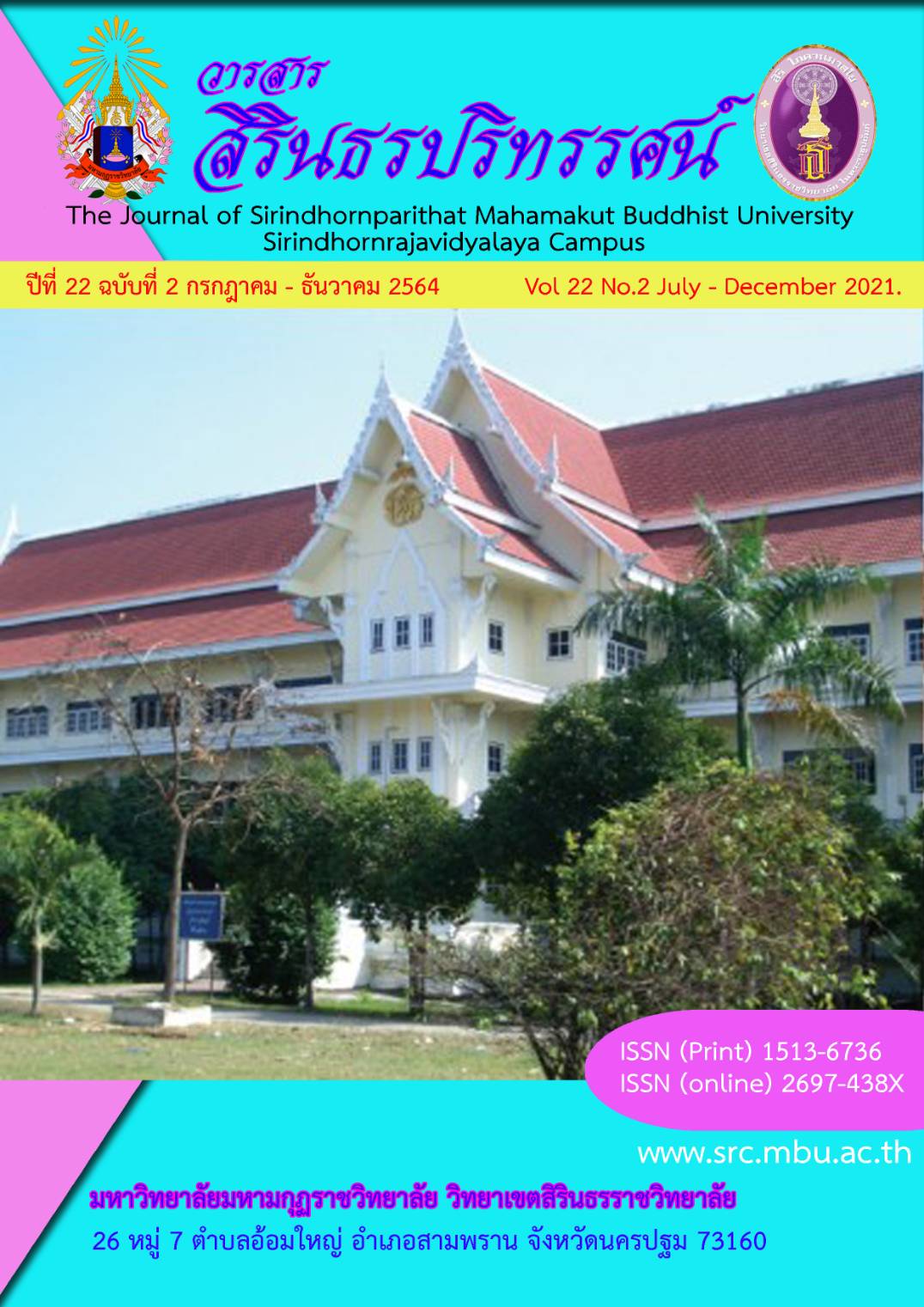Buddhist Integration With Teaching And Learning Political Science in Mahamakut Buddhist University, Sirindhorn Rajavidyalaya Campus, Nakhon Pathom Province
Keywords:
Buddhist Integration, Learning and Teaching, Political ScienceAbstract
Research was entitled “Buddhist Integration With Teaching And Learning Political Science in Mahamakut Buddhist University, Sirindhorn Rajavidyalaya Campus, Nakhon Pathom Province.” The objectives were as follows: 1. To study Buddhist Integration on learning and teaching Political Science and 2. To apply the principles of Buddhism on the influence of 4 Iddhipadas to integrate teaching and learning Political Science. This research was a survey research. Sample group were students who were studying in a bachelor's degree, years 1-4 of the Faculty of Social Sciences. The sample size was determined by the formula for calculating the sample size of Taro Yamane (Taro Yamane) from the Faculty of Social Sciences students with Government major, of Sirindhorn Rajavidyalaya Campus. It used a simple random method by drawing lots for data collection. The tool used was a questionnaire, which had the whole version of confidence equal to 0.85. The statistics used were descriptive statistics such as frequency, percentage, mean, standard deviation.
The research results were found as follows:
1. Most of the students who answered the questionnaire were male, 54.70% were male, aged 18-25, 51.38% had householder status, 74.59% had a householder status and studied in 4th year 40.330%.
2. The results of the analysis of Buddhist integration with the teaching and learning of political science in Mahamakut Buddhist University, Sirindhorn Rajavidyalaya Campus, Nakhon Pathom Province, were found that the students had opinions towards Buddhism and the teaching of political science, in overall at a high level ( x̄ = 4.19, S.D. 0.05) and when considering each aspect, it was found that the aspect of learning and teaching was at the highest level ( x̄ = 4.24, S.D. = 0.06) ( x̄ = 4.19, S.D = 0.06) and the aspect of teaching support ( x̄ = 4.16, S.D = 0.06).
References
กิตตินันท์ มลิทอง. (2543). เทคโนโลยีการศึกษาและนวัตกรรรม. พิมพ์ครั้งที่ 2. กรุงเทพมหานคร : อรุณการพิมพ์.
ทะเบียน. (2563). วิทยาเขตสิรินธรราชวิทยาลัย.
ทัศนีย์ ศุภเมธี. (2533). พฤติกรรมการสอนวิชาภาษาไทยระดับมัธยมศึกษา. กรุงเทพมหานคร : สถาบันราชภัฏธนบุรี.
ธีระศักดิ์ อุ่นอารมณ์เลิศ. (2549). เครื่องมือวิจัยทางการศึกษา : การสร้างและการพัฒนา. นครปฐม : ภาควิชาพื้นฐานทางการศึกษา คณะศึกษาศาสตร์ มหาวิทยาลัยศิลปากร.
วศิน อินทสระ. (2545). พุทธวิธีในการสอน. กรุงเทพมหานคร : สำนักพิมพ์ธรรมดา.
วิชัย วงษ์ใหญ่. (2537). กระบวนการพัฒนาหลักสูตรและการเรียนการสอนภาคปฏิบัติ. กรุงเทพมหานคร : สุวีริยาสาส์น.
สมปราชญ์ อัมมะพันธุ์. (2547). วิทยากรต้องรู้. กรุงเทพมหานคร : โอ. เอส. พริ้นติ้งเฮ้าส์.
สุมน อมรวิวัฒน์. (2539). การเรียนรู้ตามนัยแห่งพุทธธรรม. กรุงเทพมหานคร : มูลนิธิสดศรีสฤษดิ์วงษ์.
Markert, Linda Rae. (1989). Contemporary Technology: Innovations, Perspectives, Illinois : The Goodheart, Willcox Company.
Downloads
Published
Issue
Section
License
Copyright (c) 2022 Mahamakut Buddhist University

This work is licensed under a Creative Commons Attribution-NonCommercial-NoDerivatives 4.0 International License.
บทความที่ได้รับการตีพิมพ์เป็นลิขสิทธิ์ของ มหาวิทยาลัยมหามกุฏราชวิทยาลัย วิทยาเขตสิรินธรราชวิทยาลัย
ข้อความที่ปรากฏในบทความแต่ละเรื่องในวารสารวิชาการเล่มนี้เป็นความคิดเห็นส่วนตัวของผู้เขียนแต่ละท่านไม่เกี่ยวข้องกับหาวิทยาลัยมหามกุฏราชวิทยาลัย วิทยาเขตสิรินธรราชวิทยาลัย และคณาจารย์ท่านอื่นๆในมหาวิทยาลัยฯ แต่อย่างใด ความรับผิดชอบองค์ประกอบทั้งหมดของบทความแต่ละเรื่องเป็นของผู้เขียนแต่ละท่าน หากมีความผิดพลาดใดๆ ผู้เขียนแต่ละท่านจะรับผิดชอบบทความของตนเองแต่ผู้เดียว




